+ データを開く
データを開く
- 基本情報
基本情報
| 登録情報 |  | |||||||||
|---|---|---|---|---|---|---|---|---|---|---|
| タイトル | HIV 16055.v8.3 SOSIP Env in Complex with Base and N625 Epitope pAbs from Rabbit 2463 | |||||||||
 マップデータ マップデータ | ||||||||||
 試料 試料 |
| |||||||||
 キーワード キーワード | HIV / EMPEM / Polyclonal Antibodies / Rabbit / N625 / Base / SOSIP / VIRAL PROTEIN | |||||||||
| 機能・相同性 |  機能・相同性情報 機能・相同性情報positive regulation of plasma membrane raft polarization / positive regulation of receptor clustering / host cell endosome membrane / clathrin-dependent endocytosis of virus by host cell / viral protein processing / fusion of virus membrane with host plasma membrane / fusion of virus membrane with host endosome membrane / viral envelope / virion attachment to host cell / host cell plasma membrane ...positive regulation of plasma membrane raft polarization / positive regulation of receptor clustering / host cell endosome membrane / clathrin-dependent endocytosis of virus by host cell / viral protein processing / fusion of virus membrane with host plasma membrane / fusion of virus membrane with host endosome membrane / viral envelope / virion attachment to host cell / host cell plasma membrane / virion membrane / structural molecule activity / membrane 類似検索 - 分子機能 | |||||||||
| 生物種 |    Human immunodeficiency virus 1 (ヒト免疫不全ウイルス) Human immunodeficiency virus 1 (ヒト免疫不全ウイルス) | |||||||||
| 手法 | 単粒子再構成法 / クライオ電子顕微鏡法 / 解像度: 3.3 Å | |||||||||
 データ登録者 データ登録者 | Brown S / Antanasijevic A / Ward AB | |||||||||
| 資金援助 |  米国, 2件 米国, 2件
| |||||||||
 引用 引用 |  ジャーナル: Sci Immunol / 年: 2025 ジャーナル: Sci Immunol / 年: 2025タイトル: Anti-immune complex antibodies are elicited during repeated immunization with HIV Env immunogens. 著者: Sharidan Brown / Aleksandar Antanasijevic / Leigh M Sewall / Daniel Montiel Garcia / James Ferguson / Philip J M Brouwer / Rogier W Sanders / Andrew B Ward /    要旨: Vaccination strategies against HIV-1 aim to elicit broadly neutralizing antibodies (bnAbs) using prime-boost regimens with HIV envelope (Env) immunogens. Epitope mapping has shown that early antibody ...Vaccination strategies against HIV-1 aim to elicit broadly neutralizing antibodies (bnAbs) using prime-boost regimens with HIV envelope (Env) immunogens. Epitope mapping has shown that early antibody responses are directed to easily accessible nonneutralizing epitopes on Env instead of bnAb epitopes. Autologously neutralizing antibody responses appear upon boosting, once immunodominant epitopes are saturated. Here, we use electron microscopy-based polyclonal epitope mapping (EMPEM) to elucidate how repeated immunization with HIV Env SOSIP immunogens results in the generation of Ab2α anti-idiotypic antibodies in rabbits and rhesus macaques. We present the structures of six anti-immune complex antibodies and find that they target idiotopes composed of framework regions of antibodies bound to Env. Examination of cryo-electron microscopy density enabled prediction of sequences for an anti-immune complex antibody, the paratope of which is enriched with aromatic amino acids. This work sheds light on current vaccine development efforts for HIV, as well as for other pathogens in which repeated exposure to antigen is required. | |||||||||
| 履歴 |
|
- 構造の表示
構造の表示
| 添付画像 |
|---|
- ダウンロードとリンク
ダウンロードとリンク
-EMDBアーカイブ
| マップデータ |  emd_43967.map.gz emd_43967.map.gz | 393.2 MB |  EMDBマップデータ形式 EMDBマップデータ形式 | |
|---|---|---|---|---|
| ヘッダ (付随情報) |  emd-43967-v30.xml emd-43967-v30.xml emd-43967.xml emd-43967.xml | 26.5 KB 26.5 KB | 表示 表示 |  EMDBヘッダ EMDBヘッダ |
| FSC (解像度算出) |  emd_43967_fsc.xml emd_43967_fsc.xml | 17.1 KB | 表示 |  FSCデータファイル FSCデータファイル |
| 画像 |  emd_43967.png emd_43967.png | 533.6 KB | ||
| マスクデータ |  emd_43967_msk_1.map emd_43967_msk_1.map | 421.9 MB |  マスクマップ マスクマップ | |
| Filedesc metadata |  emd-43967.cif.gz emd-43967.cif.gz | 7.2 KB | ||
| その他 |  emd_43967_half_map_1.map.gz emd_43967_half_map_1.map.gz emd_43967_half_map_2.map.gz emd_43967_half_map_2.map.gz | 339.1 MB 338.2 MB | ||
| アーカイブディレクトリ |  http://ftp.pdbj.org/pub/emdb/structures/EMD-43967 http://ftp.pdbj.org/pub/emdb/structures/EMD-43967 ftp://ftp.pdbj.org/pub/emdb/structures/EMD-43967 ftp://ftp.pdbj.org/pub/emdb/structures/EMD-43967 | HTTPS FTP |
-検証レポート
| 文書・要旨 |  emd_43967_validation.pdf.gz emd_43967_validation.pdf.gz | 1.1 MB | 表示 |  EMDB検証レポート EMDB検証レポート |
|---|---|---|---|---|
| 文書・詳細版 |  emd_43967_full_validation.pdf.gz emd_43967_full_validation.pdf.gz | 1.1 MB | 表示 | |
| XML形式データ |  emd_43967_validation.xml.gz emd_43967_validation.xml.gz | 24.6 KB | 表示 | |
| CIF形式データ |  emd_43967_validation.cif.gz emd_43967_validation.cif.gz | 32.4 KB | 表示 | |
| アーカイブディレクトリ |  https://ftp.pdbj.org/pub/emdb/validation_reports/EMD-43967 https://ftp.pdbj.org/pub/emdb/validation_reports/EMD-43967 ftp://ftp.pdbj.org/pub/emdb/validation_reports/EMD-43967 ftp://ftp.pdbj.org/pub/emdb/validation_reports/EMD-43967 | HTTPS FTP |
-関連構造データ
| 関連構造データ |  9axiMC 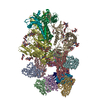 9atzC  9axdC 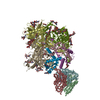 9axkC 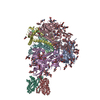 9ay6C 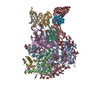 9aysC 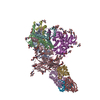 9ayvC M: このマップから作成された原子モデル C: 同じ文献を引用 ( |
|---|---|
| 類似構造データ | 類似検索 - 機能・相同性  F&H 検索 F&H 検索 |
- リンク
リンク
| EMDBのページ |  EMDB (EBI/PDBe) / EMDB (EBI/PDBe) /  EMDataResource EMDataResource |
|---|---|
| 「今月の分子」の関連する項目 |
- マップ
マップ
| ファイル |  ダウンロード / ファイル: emd_43967.map.gz / 形式: CCP4 / 大きさ: 421.9 MB / タイプ: IMAGE STORED AS FLOATING POINT NUMBER (4 BYTES) ダウンロード / ファイル: emd_43967.map.gz / 形式: CCP4 / 大きさ: 421.9 MB / タイプ: IMAGE STORED AS FLOATING POINT NUMBER (4 BYTES) | ||||||||||||||||||||||||||||||||||||
|---|---|---|---|---|---|---|---|---|---|---|---|---|---|---|---|---|---|---|---|---|---|---|---|---|---|---|---|---|---|---|---|---|---|---|---|---|---|
| 投影像・断面図 | 画像のコントロール
画像は Spider により作成 | ||||||||||||||||||||||||||||||||||||
| ボクセルのサイズ | X=Y=Z: 0.8015 Å | ||||||||||||||||||||||||||||||||||||
| 密度 |
| ||||||||||||||||||||||||||||||||||||
| 対称性 | 空間群: 1 | ||||||||||||||||||||||||||||||||||||
| 詳細 | EMDB XML:
|
-添付データ
-マスク #1
| ファイル |  emd_43967_msk_1.map emd_43967_msk_1.map | ||||||||||||
|---|---|---|---|---|---|---|---|---|---|---|---|---|---|
| 投影像・断面図 |
| ||||||||||||
| 密度ヒストグラム |
-ハーフマップ: #1
| ファイル | emd_43967_half_map_1.map | ||||||||||||
|---|---|---|---|---|---|---|---|---|---|---|---|---|---|
| 投影像・断面図 |
| ||||||||||||
| 密度ヒストグラム |
-ハーフマップ: #2
| ファイル | emd_43967_half_map_2.map | ||||||||||||
|---|---|---|---|---|---|---|---|---|---|---|---|---|---|
| 投影像・断面図 |
| ||||||||||||
| 密度ヒストグラム |
- 試料の構成要素
試料の構成要素
-全体 : HIV 16055 SOSIP Env in Complex with Base and N625 Epitope Polyclo...
| 全体 | 名称: HIV 16055 SOSIP Env in Complex with Base and N625 Epitope Polyclonal Antibodies |
|---|---|
| 要素 |
|
-超分子 #1: HIV 16055 SOSIP Env in Complex with Base and N625 Epitope Polyclo...
| 超分子 | 名称: HIV 16055 SOSIP Env in Complex with Base and N625 Epitope Polyclonal Antibodies タイプ: complex / ID: 1 / 親要素: 0 / 含まれる分子: #1-#6 |
|---|---|
| 由来(天然) | 生物種:  |
-分子 #1: Transmembrane protein gp41
| 分子 | 名称: Transmembrane protein gp41 / タイプ: protein_or_peptide / ID: 1 / 詳細: The sequence contains engineered SOSIP mutations. / コピー数: 3 / 光学異性体: LEVO |
|---|---|
| 由来(天然) | 生物種:   Human immunodeficiency virus 1 (ヒト免疫不全ウイルス) Human immunodeficiency virus 1 (ヒト免疫不全ウイルス) |
| 分子量 | 理論値: 17.430652 KDa |
| 組換発現 | 生物種:  Homo sapiens (ヒト) Homo sapiens (ヒト) |
| 配列 | 文字列: RRAVGLGAVS FGFLGAAGST MGAASITLTV QARQLLSGIV QQQSNLLKAP ECQQHLLQDG HWGIKQLQTR VLAIEHYLKD QQLLGIWGC SGKLICCTAV PWNSSWSNKS HDEIWGNMTW MQWDREISNY TNTIYRLLED SQNQQEQNEK DLLALD UniProtKB: Envelope glycoprotein gp160 |
-分子 #2: Rabbit Polyclonal Antibody N625 Epitope - Predicted Light Chain
| 分子 | 名称: Rabbit Polyclonal Antibody N625 Epitope - Predicted Light Chain タイプ: protein_or_peptide / ID: 2 詳細: The sequence of the polyclonal antibody is unknown and modeled as a poly-UNK chain. コピー数: 1 / 光学異性体: LEVO |
|---|---|
| 由来(天然) | 生物種:  |
| 分子量 | 理論値: 9.379553 KDa |
| 配列 | 文字列: (UNK)(UNK)(UNK)(UNK)(UNK)(UNK)(UNK)(UNK)(UNK)(UNK) (UNK)(UNK)(UNK)(UNK)(UNK)(UNK) (UNK)(UNK)(UNK) (UNK)(UNK)(UNK)(UNK)(UNK)(UNK)(UNK)(UNK)(UNK)(UNK) (UNK)(UNK)(UNK) (UNK)(UNK)(UNK)(UNK) ...文字列: (UNK)(UNK)(UNK)(UNK)(UNK)(UNK)(UNK)(UNK)(UNK)(UNK) (UNK)(UNK)(UNK)(UNK)(UNK)(UNK) (UNK)(UNK)(UNK) (UNK)(UNK)(UNK)(UNK)(UNK)(UNK)(UNK)(UNK)(UNK)(UNK) (UNK)(UNK)(UNK) (UNK)(UNK)(UNK)(UNK)(UNK)(UNK) (UNK)(UNK)(UNK)(UNK)(UNK)(UNK)(UNK)(UNK)(UNK)(UNK) (UNK)(UNK)(UNK)(UNK)(UNK)(UNK)(UNK)(UNK)(UNK) (UNK)(UNK)(UNK)(UNK)(UNK)(UNK)(UNK) (UNK)(UNK) (UNK)(UNK)(UNK)(UNK)(UNK)(UNK)(UNK)(UNK)(UNK)(UNK) (UNK)(UNK)(UNK)(UNK) (UNK)(UNK)(UNK)(UNK)(UNK) (UNK)(UNK)(UNK)(UNK)(UNK)(UNK)(UNK)(UNK)(UNK)(UNK) (UNK) (UNK)(UNK)(UNK)(UNK)(UNK)(UNK)(UNK)(UNK) (UNK)(UNK)(UNK)(UNK)(UNK)(UNK) |
-分子 #3: Rabbit Polyclonal Antibody N625 Epitope - Predicted Heavy Chain
| 分子 | 名称: Rabbit Polyclonal Antibody N625 Epitope - Predicted Heavy Chain タイプ: protein_or_peptide / ID: 3 詳細: The sequence of the polyclonal antibody is unknown and modeled as a poly-UNK chain. コピー数: 1 / 光学異性体: LEVO |
|---|---|
| 由来(天然) | 生物種:  |
| 分子量 | 理論値: 10.145497 KDa |
| 配列 | 文字列: (UNK)(UNK)(UNK)(UNK)(UNK)(UNK)(UNK)(UNK)(UNK)(UNK) (UNK)(UNK)(UNK)(UNK)(UNK)(UNK) (UNK)(UNK)(UNK) (UNK)(UNK)(UNK)(UNK)(UNK)(UNK)(UNK)(UNK)(UNK)(UNK) (UNK)(UNK)(UNK) (UNK)(UNK)(UNK)(UNK) ...文字列: (UNK)(UNK)(UNK)(UNK)(UNK)(UNK)(UNK)(UNK)(UNK)(UNK) (UNK)(UNK)(UNK)(UNK)(UNK)(UNK) (UNK)(UNK)(UNK) (UNK)(UNK)(UNK)(UNK)(UNK)(UNK)(UNK)(UNK)(UNK)(UNK) (UNK)(UNK)(UNK) (UNK)(UNK)(UNK)(UNK)(UNK)(UNK) (UNK)(UNK)(UNK)(UNK)(UNK)(UNK)(UNK)(UNK)(UNK)(UNK) (UNK)(UNK)(UNK)(UNK)(UNK)(UNK)(UNK)(UNK)(UNK) (UNK)(UNK)(UNK)(UNK)(UNK)(UNK)(UNK) (UNK)(UNK) (UNK)(UNK)(UNK)(UNK)(UNK)(UNK)(UNK)(UNK)(UNK)(UNK) (UNK)(UNK)(UNK)(UNK) (UNK)(UNK)(UNK)(UNK)(UNK) (UNK)(UNK)(UNK)(UNK)(UNK)(UNK)(UNK)(UNK)(UNK)(UNK) (UNK) (UNK)(UNK)(UNK)(UNK)(UNK)(UNK)(UNK)(UNK) (UNK)(UNK)(UNK)(UNK)(UNK)(UNK)(UNK)(UNK) (UNK) (UNK)(UNK)(UNK)(UNK)(UNK)(UNK) |
-分子 #4: Rabbit Polyclonal Antibody Base Epitope - Predicted Heavy Chain
| 分子 | 名称: Rabbit Polyclonal Antibody Base Epitope - Predicted Heavy Chain タイプ: protein_or_peptide / ID: 4 詳細: The sequence of the polyclonal antibody is unknown and modeled as a poly-UNK chain. コピー数: 1 / 光学異性体: LEVO |
|---|---|
| 由来(天然) | 生物種:  |
| 分子量 | 理論値: 10.400812 KDa |
| 配列 | 文字列: (UNK)(UNK)(UNK)(UNK)(UNK)(UNK)(UNK)(UNK)(UNK)(UNK) (UNK)(UNK)(UNK)(UNK)(UNK)(UNK) (UNK)(UNK)(UNK) (UNK)(UNK)(UNK)(UNK)(UNK)(UNK)(UNK)(UNK)(UNK)(UNK) (UNK)(UNK)(UNK) (UNK)(UNK)(UNK)(UNK) ...文字列: (UNK)(UNK)(UNK)(UNK)(UNK)(UNK)(UNK)(UNK)(UNK)(UNK) (UNK)(UNK)(UNK)(UNK)(UNK)(UNK) (UNK)(UNK)(UNK) (UNK)(UNK)(UNK)(UNK)(UNK)(UNK)(UNK)(UNK)(UNK)(UNK) (UNK)(UNK)(UNK) (UNK)(UNK)(UNK)(UNK)(UNK)(UNK) (UNK)(UNK)(UNK)(UNK)(UNK)(UNK)(UNK)(UNK)(UNK)(UNK) (UNK)(UNK)(UNK)(UNK)(UNK)(UNK)(UNK)(UNK)(UNK) (UNK)(UNK)(UNK)(UNK)(UNK)(UNK)(UNK) (UNK)(UNK) (UNK)(UNK)(UNK)(UNK)(UNK)(UNK)(UNK)(UNK)(UNK)(UNK) (UNK)(UNK)(UNK)(UNK) (UNK)(UNK)(UNK)(UNK)(UNK) (UNK)(UNK)(UNK)(UNK)(UNK)(UNK)(UNK)(UNK)(UNK)(UNK) (UNK) (UNK)(UNK)(UNK)(UNK)(UNK)(UNK)(UNK)(UNK) (UNK)(UNK)(UNK)(UNK)(UNK)(UNK)(UNK)(UNK) (UNK) (UNK)(UNK)(UNK)(UNK)(UNK)(UNK)(UNK)(UNK)(UNK) |
-分子 #5: Rabbit Polyclonal Antibody Base Epitope - Predicted Light Chain
| 分子 | 名称: Rabbit Polyclonal Antibody Base Epitope - Predicted Light Chain タイプ: protein_or_peptide / ID: 5 詳細: The sequence of the polyclonal antibody is unknown and modeled as a poly-UNK chain. コピー数: 1 / 光学異性体: LEVO |
|---|---|
| 由来(天然) | 生物種:  |
| 分子量 | 理論値: 9.294448 KDa |
| 配列 | 文字列: (UNK)(UNK)(UNK)(UNK)(UNK)(UNK)(UNK)(UNK)(UNK)(UNK) (UNK)(UNK)(UNK)(UNK)(UNK)(UNK) (UNK)(UNK)(UNK) (UNK)(UNK)(UNK)(UNK)(UNK)(UNK)(UNK)(UNK)(UNK)(UNK) (UNK)(UNK)(UNK) (UNK)(UNK)(UNK)(UNK) ...文字列: (UNK)(UNK)(UNK)(UNK)(UNK)(UNK)(UNK)(UNK)(UNK)(UNK) (UNK)(UNK)(UNK)(UNK)(UNK)(UNK) (UNK)(UNK)(UNK) (UNK)(UNK)(UNK)(UNK)(UNK)(UNK)(UNK)(UNK)(UNK)(UNK) (UNK)(UNK)(UNK) (UNK)(UNK)(UNK)(UNK)(UNK)(UNK) (UNK)(UNK)(UNK)(UNK)(UNK)(UNK)(UNK)(UNK)(UNK)(UNK) (UNK)(UNK)(UNK)(UNK)(UNK)(UNK)(UNK)(UNK)(UNK) (UNK)(UNK)(UNK)(UNK)(UNK)(UNK)(UNK) (UNK)(UNK) (UNK)(UNK)(UNK)(UNK)(UNK)(UNK)(UNK)(UNK)(UNK)(UNK) (UNK)(UNK)(UNK)(UNK) (UNK)(UNK)(UNK)(UNK)(UNK) (UNK)(UNK)(UNK)(UNK)(UNK)(UNK)(UNK)(UNK)(UNK)(UNK) (UNK) (UNK)(UNK)(UNK)(UNK)(UNK)(UNK)(UNK)(UNK) (UNK)(UNK)(UNK)(UNK)(UNK) |
-分子 #6: Surface protein gp120
| 分子 | 名称: Surface protein gp120 / タイプ: protein_or_peptide / ID: 6 詳細: The sequence contains engineered SOSIP mutations. The sequence contains an expression tag and initiating methionine residue. コピー数: 3 / 光学異性体: LEVO |
|---|---|
| 由来(天然) | 生物種:   Human immunodeficiency virus 1 (ヒト免疫不全ウイルス) Human immunodeficiency virus 1 (ヒト免疫不全ウイルス) |
| 分子量 | 理論値: 58.156312 KDa |
| 組換発現 | 生物種:  Homo sapiens (ヒト) Homo sapiens (ヒト) |
| 配列 | 文字列: MDAMKRGLCC VLLLCGAVFV SPSQEIHARF RRGARNGNLW VTVYYGVPVW KDAETTLFCA SDAKAYEKEK RNVWATHCCV PTDPNPQEM VLENVTENFN MWKNDMVEQM HEDVISLWDQ SLKPCVKLTP LCVTLECRQV NTTNATSSVN VTNGEEIKNC S FNATTELR ...文字列: MDAMKRGLCC VLLLCGAVFV SPSQEIHARF RRGARNGNLW VTVYYGVPVW KDAETTLFCA SDAKAYEKEK RNVWATHCCV PTDPNPQEM VLENVTENFN MWKNDMVEQM HEDVISLWDQ SLKPCVKLTP LCVTLECRQV NTTNATSSVN VTNGEEIKNC S FNATTELR DKKQKVYALF YRLDIVPLEE ERKGNSSKYR LINCNTSAIT QACPKVTFDP IPIHYCAPAG YAILKCNNKT FN GTGPCNN VSTVQCTHGI KPVVSTQLLL NGSLAEGEII IRSENLTNNV KTIIVHLNES VEIVCTRPNN NTVKSIRIGP GQW FYYTGD IIGNIRQAYC NIKKDDWIRT LQRVGKKLAE HFPRRIINFT QPAGGDLEIT THSFNCRGEF FYCNTSSLFN STYN PNDTN SNSSSSNSSL DITIPCRIKQ IINMWQRVGQ AMYAPPIEGN ITCKSNITGL LLVRDGGVES NETEIFRPGG GDMRN NWRS ELYKYKVVEI KPLGIAPTRC KRRVVERRRR UniProtKB: Envelope glycoprotein gp160 |
-分子 #11: 2-acetamido-2-deoxy-beta-D-glucopyranose
| 分子 | 名称: 2-acetamido-2-deoxy-beta-D-glucopyranose / タイプ: ligand / ID: 11 / コピー数: 33 / 式: NAG |
|---|---|
| 分子量 | 理論値: 221.208 Da |
| Chemical component information |  ChemComp-NAG: |
-分子 #12: alpha-D-mannopyranose
| 分子 | 名称: alpha-D-mannopyranose / タイプ: ligand / ID: 12 / コピー数: 1 / 式: MAN |
|---|---|
| 分子量 | 理論値: 180.156 Da |
| Chemical component information |  ChemComp-MAN: |
-実験情報
-構造解析
| 手法 | クライオ電子顕微鏡法 |
|---|---|
 解析 解析 | 単粒子再構成法 |
| 試料の集合状態 | particle |
- 試料調製
試料調製
| 濃度 | 4.2 mg/mL |
|---|---|
| 緩衝液 | pH: 7.4 |
| グリッド | モデル: Quantifoil R1.2/1.3 / 材質: COPPER / メッシュ: 400 / 支持フィルム - 材質: CARBON / 支持フィルム - トポロジー: HOLEY / 前処理 - タイプ: GLOW DISCHARGE |
| 凍結 | 凍結剤: ETHANE / チャンバー内湿度: 100 % / チャンバー内温度: 283 K / 装置: FEI VITROBOT MARK IV |
- 電子顕微鏡法
電子顕微鏡法
| 顕微鏡 | TFS KRIOS |
|---|---|
| 撮影 | フィルム・検出器のモデル: GATAN K3 (6k x 4k) / 実像数: 3798 / 平均電子線量: 40.3 e/Å2 |
| 電子線 | 加速電圧: 300 kV / 電子線源:  FIELD EMISSION GUN FIELD EMISSION GUN |
| 電子光学系 | 照射モード: FLOOD BEAM / 撮影モード: BRIGHT FIELD / 最大 デフォーカス(公称値): 2.0 µm / 最小 デフォーカス(公称値): 0.8 µm |
| 試料ステージ | ホルダー冷却材: NITROGEN |
| 実験機器 |  モデル: Titan Krios / 画像提供: FEI Company |
 ムービー
ムービー コントローラー
コントローラー

























 Z (Sec.)
Z (Sec.) Y (Row.)
Y (Row.) X (Col.)
X (Col.)













































